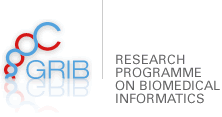
7/10/2010
Thesis of Adrian López: Computational Approaches to the Modelling of Topological and Dynamical Aspects of Biochemical Networks. PRBB, October the 19th at 11:00
Adrián López, member of Computational Biochemistry and Biophysics laboratory of GRIB (UPF/ IMIM) will defence his thesis the 19th of October 2010 at 11:00 in the Parc Recerca Biomedica de Barcelona (PRBB) at XIPRE Seminar at the 1st floor of the building.
This thesis verses about "Computational Approaches to the Modelling of Topological and Dynamical Aspects of Biochemical Networks".
Abstract: Regulatory mechanisms of cells can be modelled to control and under-stand cellular biology. Different levels of abstraction are used to describe biological processes. In this work we have used graphs and diferential equations to model cellular interactions qualitatively and quantitatively.
From different organisms, E. coli and S. cerevisiae, we have analysed data available for they complete interaction and activity networks. At the level of interaction, the protein-protein interaction network, the transcriptional regulatory networks and the metabolic network have been studied; for the activity, both gene and protein profiles of the whole organism have been examined. From the rich variety of graph measures, one of primer importance is the degree distribution. I have applied statistical analysis tools to such biological networks in order to characterise the degree distribution. In all cases the studied degree distributions have a heavy-tailed shape, but most of them present significant differences from a power-law model according to a statistical test. Moreover, none of the networks could be unequivocally assigned to any of the tested distribution.
On the other hand, in a more fine-grained view, I have used differential equations to model dynamics of biochemical systems. First, a software tool called ByoDyn has been created from scratch incorporating a fairly complete range of analysis methods. Both deterministic and stochastic simulations can be performed, models can be analysed by means of parameter estimation, sensitivity, identifiability analysis, and optimal experimental design. Moreover, a web interface has been created that provides with the possibility interact with the program in a graphical manner, independent of the user configuration, allowing the execution of the program at different computational environments. Finally, we have applied a protocol of optimal experimental design on a multicellular model of embryogenesis.



